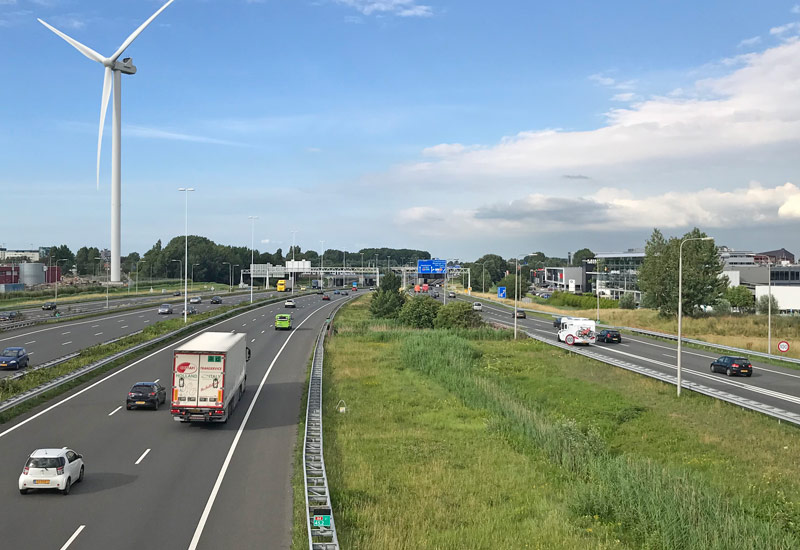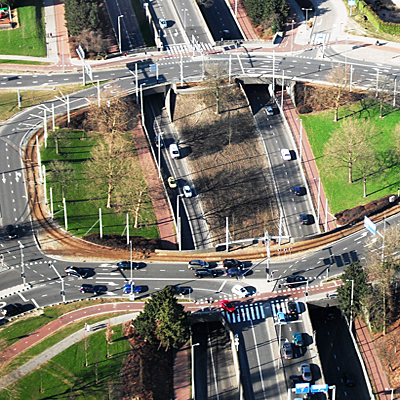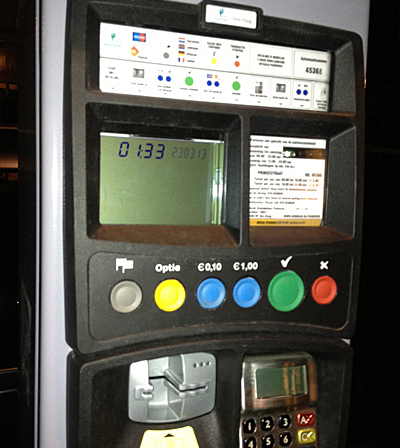Driving In The Netherlands
Newly arrived expats who plan on driving in the Netherlands need to become familiar with Dutch traffic rules: speed limits, road signs, transporting children, sharing the road with cyclists, accident protocol and more…

DUTCH DRIVING RULES & REGULATIONS
Here are the most important rules for driving in the Netherlands:
- Drive on the right, overtake on the left.
- 18 years is the legal minimum age to drive a car unsupervised (or ride a motorbike with an engine capacity over 125cc).
- 16 is the legal minimum age to ride a scooter or moped (‘bromfiets’).
- Motorcycle and trike drivers (and any passengers) must wear crash helmets.
- It is compulsory to be in possession of a valid driving license, car registration papers and insurance documents when driving a car in the Netherlands. A Dutch, EU or International driving license is acceptable unless the driver holds non-EU citizenship and has been residing in the Netherlands for more than 180 days. In this case he/she must have a valid Dutch driving license (‘rijbewijs’).
- Mobiles/cellphones may only be used in connection with a hands-free system. Holding a mobile phone while operating a moving vehicle is illegal. This applies to automobiles, micro cars, motorcycles, mopeds, scooters and bicycles.
- Seat belts are compulsory for the driver and all passengers, regardless if they are in the front or back seat.
- Children under 18 years who are shorter than 1.35m must sit in an approved car seat or raised, booster seat.
- High beam headlights can only be used at night.
- Drivers in the Netherlands need to pay particular attention to bicyclists, especially at intersections.
- When approaching a priority uncontrolled intersection, vehicles coming from the right have priority.
- Buses have priority when pulling out from a bus stop inside the built-up area.
- Trams have priority except where signposted at major junctions.
DRIVING FINES
Unlike other countries that calculate fines using a table, the Netherlands calculates fines uses an algorithm that combines both the offense and the gravity of the offense depending on context. For example, exceeding the speed limit by 10km/h on a road where a construction team is working will incur a more expensive fine than exceeding the speed limit by 10km/h on the same stretch of road when no construction crew is present. There is no published list of costs for parking violations and similar fines.
Speeding fines can be calculated online at the Openbaar Ministerie (Public Prosecutor) website.
Some frequently asked questions about fines are answered in English on the Ministry of Justice website.
TRANSPORTING CHILDREN
It is obligatory that children under 18 who are less than 1.35 metres tall must travel in an EU approved child car seat or raised booster seat if (without a booster) the seat belt crosses at their neck. This applies to travelling in the front and back seats. A child under three may not be transported without being strapped in to a seat. When using a rear-facing car seat, the airbag must be deactivated.
WHAT MUST BE CARRIED
It is compulsory to carry the following when driving a car:
- Driving license (and a passport if the driving license does not include a photograph)
- Vehicle registration card
- Vehicle insurance document (not compulsory but strongly recommended)
It is also advised to carry the following items (which are not mandatory in the Netherlands but are mandatory in neighboring Germany and Belgium):
- A red warning triangle
- A reflective vest
- A first aid kit
ON THE ROAD IN HOLLAND
Understand the various road signs you see in the Netherlands…

Be aware that the Netherlands has a large number of cyclists who share the main roadway in places where a dedicated bike path is not available.
Cyclists traveling straight at a junction always have priority over cars making a turn (unless the intersection has a dedicated a turn signal).
Cyclists do not have priority when they are crossing a priority road.
Pedestrians always have priority at zebra crossings.
The Netherlands does not have toll roads.
ROAD SIGNS
The Netherlands uses many different road signs which can be confusing especially when several are used together.
As a general rule…
- triangular signs outlined in red are warning signs about potential hazards ahead
- inverted triangular signs outlined in red are priority road signs for upcoming intersections or road mergers
- round signs outlined in red are prohibitory signs where a type of vehicle or action is not allowed
- round signs with blue background are mandatory signs where a specific action or behavior is required
- square or rectangular signs on blue background are indicative signs with information about destinations, distances or directions
There are many unique road signs used in Netherlands. For example a sign that indicates a woonerf (residential area), a fietsstraat (bicycle street) or a turbo roundabout (a roundabout with added features to improve traffic flow).
For a complete overview of traffic regulations and road signs in Netherlands, see the booklet produced by the Ministry of Infrastructure and the Environment.
ROAD WORK & TRAFFIC UPDATES
The ANWB (an organisation similar to automobile associations in other countries) provides up-to-the-minute information on traffic conditions and road work.
Similar information is available in English on the website ViaMichelin
SPEED LIMITS IN THE NETHERLANDS
Speed limits are implemented rigorously and radar traps are frequent. Driving over the speed limit and other law infringements are severely punished (fines, license withheld, vehicle seized). Speed cameras, speed traps and unmarked vehicles are used by the traffic police.
Speed limits in Holland are as follows unless otherwise marked by signs:
- Motorway/Freeway (‘Autosnelweg’): Maximum speed is 130 kph (unless signed otherwise). Minimum speed is 60 kph.
- Expressway (‘Autoweg’): Maximum speed is 100 kph (unless signed otherwise). Minimum speed is 50 kph.
- Distributor roads: Maximum speed is 80 kph (unless signed otherwise).
- Regional access roads: 60 kph
- Municipal roads/Built-up areas: 50 kph
- Local access roads: 30 kph
- Housing estates/residential areas (‘Woonerf‘): 15 kph
Note that speed limits are reduced for passenger cars or vans towing a trailer, camper vans and trucks.
BREAKDOWN RECOVERY
Yellow emergency telephones on the motorway roadside connect to the ANWB for roadside assistance. The ANWB is a membership breakdown service but is open to all road users who are able to subscribe for help from the scene of a breakdown or accident.
PARKING IN HOLLAND
Parking is at a premium in most Dutch cities; there are clear regulations on who may park where, and at what times of the day…
Parking is not allowed next to black and white or yellow curbs.
There is a severe lack of parking in Amsterdam and other major cities. In an effort to reduce congestion, many cities have a park and ride scheme (P+R locaties). The driver parks in an out-of-town lot and then finishes the journey to the city center using public transport (such as tram or metro).
P-ZONE
In almost all urban districts, street parking is not free. In metered parking areas (marked by a ‘P zone’ sign), parking tickets are available from a central meter machine (usually grey or yellow) at the side of the road.

The ticket must be displayed in the front window. Failing to display a ticket, or displaying a ticket that has expired, will be fined by roaming police parking attendants. A vehicle which remains after already being fined, could result in a yellow boot (wheel locking device) being placed on the car and fining the driver. If the car is towed away the costs can run into hundreds of Euros.
Meter machines on the street vary in terms of method of payment allowed (in large urban areas, most have English-language directions).
In some cases, a bank pin/chip card or credit card will work, or in some cities a mobile app is used to pay for parking automatically (billed monthly).
BLUE ZONE
A time-stamped parking disc – displayed on the dashboard – is needed to park in urban blue zone areas. These discs are available from motor club offices, tobacco shops and police stations.
Parking is also available in large, multi-level or underground parking garages. Payment may be in cash or by pin/chip cards.
In more residential areas, permits for residents are available or a mobile app can be used to pay for parking (billed monthly)
MUNICIPAL PARKING REGULATIONS
As parking rules are set by individual municipalities and may vary from city to city, here are links to the parking guidelines for popular expat cities in the Netherlands, including resident parking permits and parking fines…
ROAD ACCIDENTS IN HOLLAND
It is obligatory for all cars registered in the Netherlands to have at least third party liability (‘wettelijke aansprakelijkheid‘) auto insurance; additional insurance (fire, theft, vandalism) is optional.
The insurance agent will provide a European Claim Form, which should be kept in the car. The claim form is the basis on which an insurance claim is made. In the event of an accident, all parties complete and sign the form at the scene. Copies are then sent to all claimants insurers for assessment.
WHAT TO DO AT THE SCENE:
- Stop immediately
- If the vehicle is blocking the road, use hazard lights and place a red warning triangle 30 meters from the scene to warn oncoming traffic
- All parties involved must exchange details:
- Name and address of all the people involved in the accident
- Vehicle registration numbers
- Insurance company details
MINOR ACCIDENTS
If the accident is not too serious (for instance, if it only involves damage to property), then take the following action:
- All parties involved in the accident complete and sign a claim form. This may be used as evidence. If there is disagreement and the form cannot be signed by all involved, the police can be asked to intervene
- The names and addresses of any witnesses should also be mentioned, as well as information on the facts of the accident
- If possible, take a photograph of the scene of the accident
The claim form must then be sent to the insurance company; in the Netherlands there is no time deadline.
ACCIDENTS INVOLVING INJURY OR DEATH
In the event of a road accident in which someone is injured or killed:
- Contact the police and call an ambulance if necessary: 112
- The police will make an official report describing the details of the accident and take note of the personal details of all people involved, including registration numbers and insurance information
- A copy of the accident report can be requested from Stichting Processen Verbaal (Foundation for Police Reports); mention the time and place (municipality) where the accident took place and include relevant vehicle registration numbers.
- If the police do not attend the scene of the accident, those involved must collect the names and addresses of all relevant parties and witnesses. The European claim form may be used and signed by all
- Taking photographs or drawing a sketch of the scene is advisable
- Note: Leaving the scene of an accident without providing this information is considered an offence.
If the party responsible for the damage is uninsured or unknown, the claim can be submitted to the Road Traffic Guarantee Fund (Waarborgfonds Motorverkeer).
ACCIDENTS OUTSIDE THE NETHERLANDS
The 5th Motor Insurance Directive is in force in the European Union regarding traffic accidents outside a person’s own country: victims of traffic accidents can now claim compensation in a simple manner from the insurer of the party at fault. These claims are submitted to the representative of the foreign insurer in the victim’s country.
INTERNATIONAL ACCIDENT WITH FATALITY
Should a fatality occur in an accident, the deceased will be taken to a mortuary. The family is usually asked to identify the body. The Crown Prosecutor’s Office (Officier van Justitie) may investigate the cause of death. In such cases, the Officier van Justitie will give permission for the cremation or burial.
RELEVANT DUTCH ORGANIZATIONS
- Politie (Dutch Police)
- ANWB Juridisch Advies (Dutch Auto Club Legal Services)
- Vereniging Verkeersslachtoffers (Association of Road Victims)
- Nederlands Bureau Motorrijtuigverzekeraars (Dutch Motor Insurer’s Bureau)
- Slachtoffer HULP Nederland (Victim Support Association)
- Waarborgfonds Motorverkeer (Road Traffic Guarantee Fund)
Related information…

